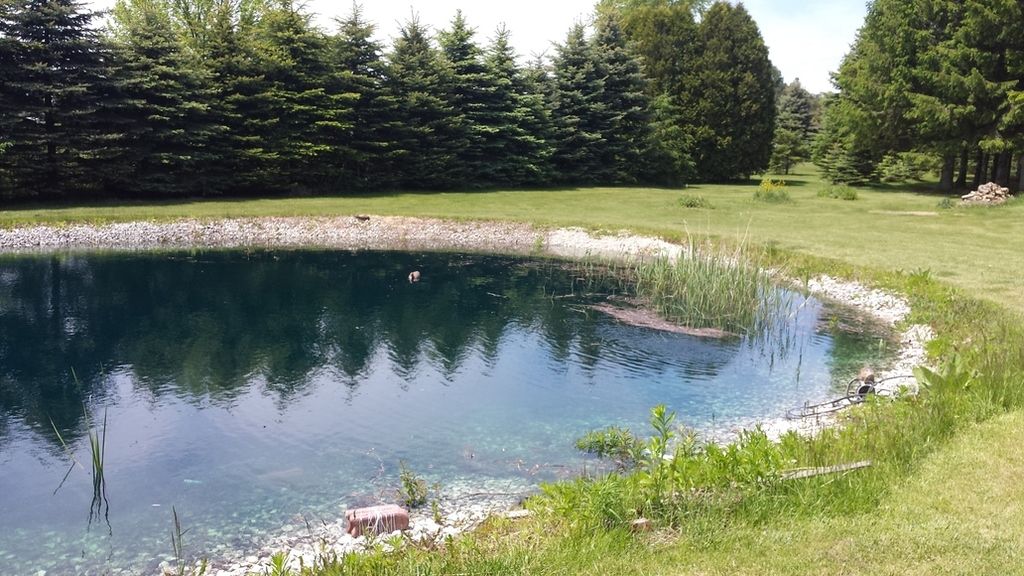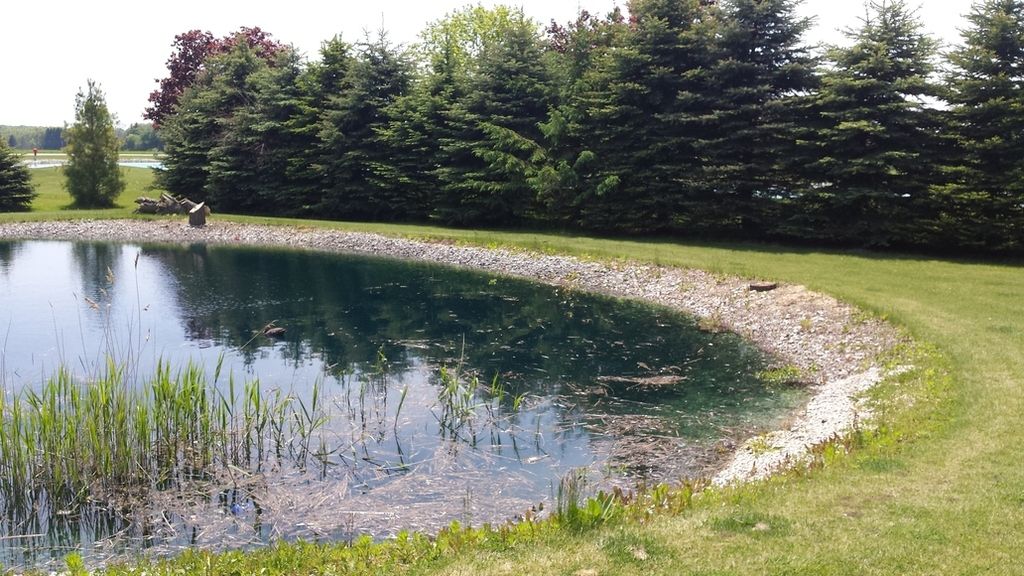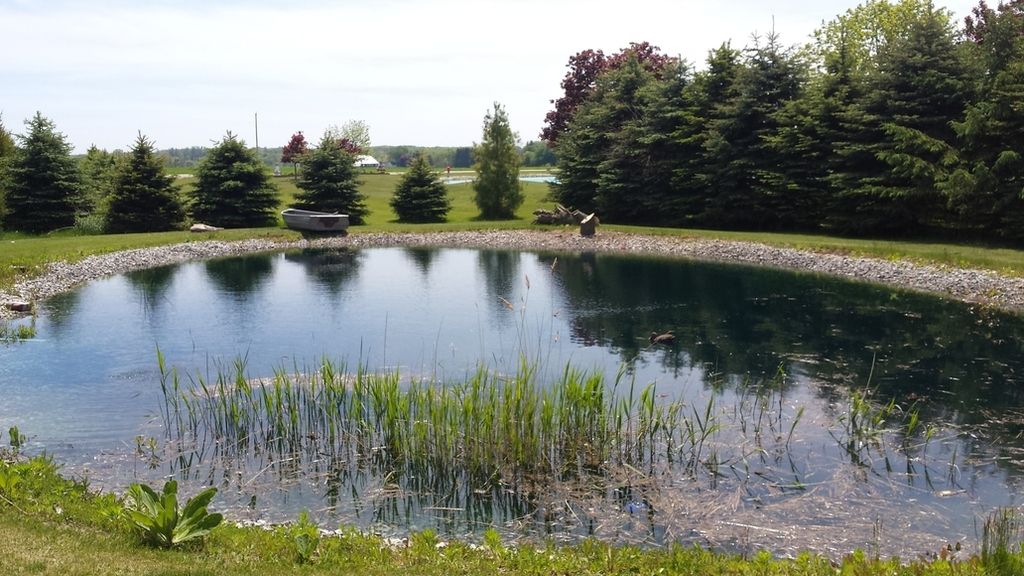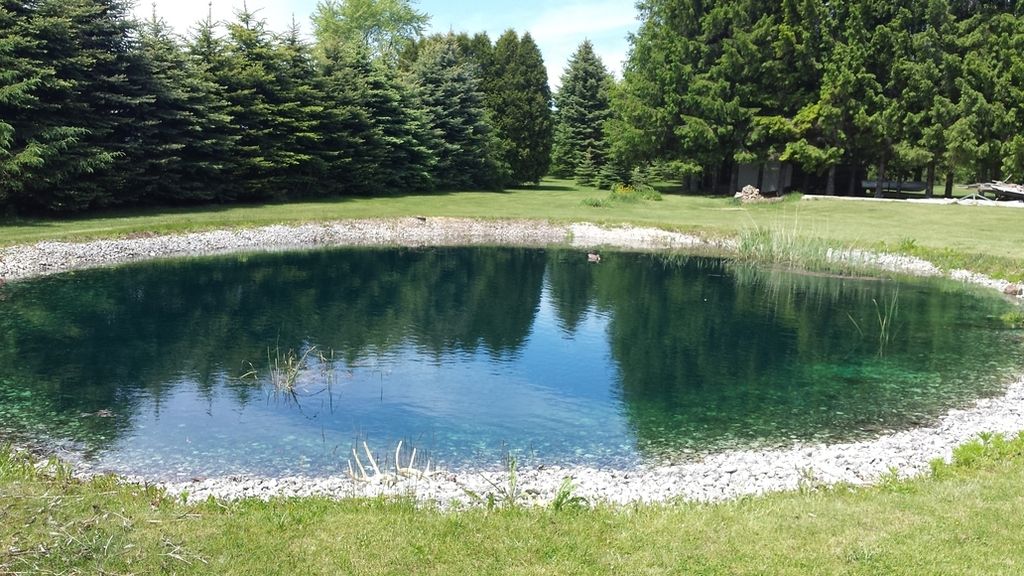Had a thread going about aeration system design in that area, but decided to focus on bigger issues with my "new to me" pond. Bought a house last year, didn't really give much attention to the pond as it was a foreclosure and I was working on the house.
The pond is about 1/10 acre, maybe smaller. Had two willow trees that were about 40' tall and approximately 8 years old according to neighbors. They were right on the bank of the pond and have been cut down for a few weeks, I also put tordon stump killer on them.
The pond has a incoming fill line (running from seperate well pump) that I can control with a switch in the house. This line is about 1.5 ft from the top of the bank. So far I have filled the pond, sprayed it with some sort of algae/weed killer from our local pond guy and also dyed it blue.
The first problem I am having is keeping the pond full. First off, I'm not exactly sure where the "full" level is intended to be, I would assume almost to the top of the bank which would make the pond 10' deep or right around there. However, if I fill it up that high, I lose water rather quickly (several inches per day). If I don't fill the pond, it will drop several feet, probably at least 4 or 5 leaving a large area of a steep bank exposed, this can happen within a month. I am in WI and we haven't had a ton of warm weather. After it dries up this far, I think I still have about 5' or so of water left. I've never left it go completely without filling and forgot to measure it in spring, (didn't fill it in winter)
I feel sort of stuck as the local pond guy said he wouldn't touch it because he couldn't guarantee anything, I completely understood his position. However, I'm not one to give up and I have access to a large tracked skid-steer and 18 yard dump truck from my in-laws so I have an inkling that I can fix this thing and get it to the point were we can enjoy it and make it more efficient.
As of tomorrow pond will be full to top of bank, I planned on taking pics and measurements everyday to help show the problem I am dealing with. Is there anything else as far as information that I could provide, again, I'm hoping someone can help...I'm running out of hair to pull! I appreciate any input and or help! Matt
Are there fish in there now? I might go the other way...The pond isn't that big. I would pump it down and see what I had.
1/10 acre with approximate average depth of 6' would be less than 200,000 gallons. A 3" trash pump could make short work of it. Once the soils are exposed you will know exactly what you have to work with.
mnfish, no fish in there as of yet, I have no aeration so didn't want to try it. Lots of frogs though, which are quite entertaining for the dog.
I don't know if I'm correct in my thinking, hence asking for advice, I wanted to see the minimum point at which the pond would stop leaking, if there is one, I assume there is otherwise it would have been empty in spring. I'm not opposed to emptying it with a pump and seeing what I have either.
I thought I read somewhere, that rate of loss can help determine if the leak is on the bottom of the pond or on the sides. Maybe I'm thinking of something else, been doing a ton of research and may be confused.
Matt
Your idea of letting Mother Nature drain the pond is a good one, see when and where the water stops leaking it may help make the decision of what to do next.
With no fish, nothing to lose but some time at this point, nice.
When I say "go the other way", i mean to drain and let mother nature fill it back up. Verses filling and letting the water recede. Same test with a different approach. But with the added benefits of drawing a pond down to empty.
Good luck and can't wait to see the pic's.
mnfish, I fear that if I drain and hold off until mother nature fills it, it will be years before it fills back in. When it rains there really is no difference in the pond level, even with a heavy downpour. There is really no runoff going to it and no springs, etc. I took some pics today, so will figure out how to upload them tonight or tomorrow.
Thanks for your help so far!
Matt
mnfish, I fear that if I drain and hold off until mother nature fills it, it will be years before it fills back in. When it rains there really is no difference in the pond level, even with a heavy downpour. There is really no runoff going to it and no springs, etc. I took some pics today, so will figure out how to upload them tonight or tomorrow.
Thanks for your help so far!
Matt
Duckfoot,
I think what mnfish means is, drain her down. There may be an underground creek, seam, or stream that is filling your pond to a specific level, but the pressure may not be great enough to fill it all the way and the water may be heading back the other way (out) when you supplement the water supply to full pool.
Yes sir Stickem.
How about a couple more questions Duckfoot then, FWIW, I will give you my reasoning for drawing it down. Questions first.
1. Is the pond a dug out pond?
2. Is there any other wet areas close to the pond (Within couple hundred feet)?
3. If the answer to 2. yes, have you ever built or used a water level?
4. How is the picture posting coming along?

I see what your getting at, the light bulb just flickered a bit. Answers to your questions are as follows:
1. Yes, the pond was dug, and not natural.
2. There is one small wet area right on the property line, my property is 1.5 acres total. It is about 30 feet from the pond, however, it is on the neighbors property. It is only wet when it rains and then after a day or two drys up. Besides that, my neighbor has about a 2.5 acre pond about 300 feet from mine, he does have a well feeding his occasionally he stated.
3. No have never built or used a water level, I am pretty. handy so I'm sure its not out of my capabilities.
4. Hopefully tonight, just got doing my patio and going to clean up and attempt to upload!
Thank you again for your time and knowledge, it is truly awesome that so many people on here are willing to help a guy out!
Matt
north shoreline

west shoreline

facing south

facing north

Without seeing your pond it would be impossible to tell you whats going on. IME I see this quite often here in MN:
The spoils (soil excavated out of the hole) from the digging of the pond were most likely spread around the outside edges of the dug hole. Obviously, it is much less expensive to spread the dirt on site than to truck it away. The spoils then create a raised rim around the dug hole. Depending on the amount of soil removed, the rim could be 1'-6' high. This rim is above the natural water table. Its mixed soil and most likely not hold water. Not saying this is what you have but by drawing it down you will quickly learn how the water flows back in and probably see the natural water line of the current water table.
The poor mans water level (a inter web search with surly explain this better than I can here but I will try): A 5 gallon bucket filled with water and a couple hundred feet of flexible 1/2" tygon tubing. The tubing is fixed and sealed into the side of a 5 gallon towards the bottom. Plug the other end of the tubing with a threaded bolt. Water seeks its level no matter what. Set the 5 gallon bucket 2-3' above ground level. Measure the distance from the resting bucket to the ground. With the 5 gallon fixed and filled with water, it is a reference point for level. A person could walk, up to the length of the tubing, remove the bolt, and the water in the tubing will come to rest. Measure the distance from the water to the ground. This will tell you how much higher or lower from the bucket that point is. For example, the bucket is sitting 2' off of the ground. You walk the tubing to a spot and take a measurement. The water in the tubing is 3' from the ground. The rise in soil is then 1'. I hope this makes sense. My father showed me this years ago and built me one for about $10.
I just saw the pics after posting... Beautiful pond!
I would say, I still can't be positive, but those pics would lean me further towards my post about the spoil pile rim.
I'm not sure my acreage can handle 200,000 gallons of water without making a mess of everything so I will let it drain naturally for a bit. When it seems like it isn't draining anymore I'll pump it out per your advice and see what I got.
Without getting to far ahead of myself here, if the rim is leaking, how does one go about fixing it. My initial thought was lining the bottom with 1 to 2 more feet of clay and bentonite mixture, then pushing the rock of the rim onto the bottom of the pond, then lining up the sides with clay and bentonite, I would probably make them less steep as well. Not sure if that makes sense or would work. Again, I'm probably putting the cart before the horse, but this was a brainstorm I had.
I will post some more pics as she drains and when I got it empty. I'm expecting to also see some tree roots from the old willows.
Matt
You got options! Post the pics as the water recedes. There are some very good pond builders here that can give you ideas and solutions. IMHO, your plan is solid. Come august you will know a lot more and then can decide to draw down or not.
Look forward to seeing this project progress and I'm sure we will all learn something from it.
Want some cheap fun and get started with the true addiction while you wait. Go to the bait store and buy 3-4 scoops of FHM's and dump them into the pond. Watch them multiple and kick some mosquito larva butt

One of the questions I have on this pond is regarding fish. If I choose not to fix the "leak" and I continue to pump well water which is about 52 or so degrees at a rate of about 3000-4000 gallons per day(my calculated loss with rough numbers) which will help cool the pond, do you think it would be a viable option for trout? My well pump puts out at max rate about 16,000 gallons per day if needed.
I know there is a lot of other variables, I have aeration planned etc and there are other variables, but maybe the leak wouldn't be a bad thing if it allowed me to keep cooler water in the pond? I would have to take temp readings in summer to determine temps, etc, so this was just a brainstorm trying to make best of the situation.
Matt
The poor mans water level (a inter web search with surly explain this better than I can here but I will try): A 5 gallon bucket filled with water and a couple hundred feet of flexible 1/2" tygon tubing. The tubing is fixed and sealed into the side of a 5 gallon towards the bottom. Plug the other end of the tubing with a threaded bolt. Water seeks its level no matter what. Set the 5 gallon bucket 2-3' above ground level. Measure the distance from the resting bucket to the ground. With the 5 gallon fixed and filled with water, it is a reference point for level. A person could walk, up to the length of the tubing, remove the bolt, and the water in the tubing will come to rest. Measure the distance from the water to the ground. This will tell you how much higher or lower from the bucket that point is. For example, the bucket is sitting 2' off of the ground. You walk the tubing to a spot and take a measurement. The water in the tubing is 3' from the ground. The rise in soil is then 1'. I hope this makes sense. My father showed me this years ago and built me one for about $10.
Very cool idea!
if the rim is leaking, how does one go about fixing it. My initial thought was lining the bottom with 1 to 2 more feet of clay and bentonite mixture, then pushing the rock of the rim onto the bottom of the pond, then lining up the sides with clay and bentonite, I would probably make them less steep as well. Not sure if that makes sense or would work.
FWIW I have a water table pond and, IMO, it sounds like you might as well. I don't know a way of sealing a water table pond but perhaps someone else does (maybe a rubber liner?). With my pond, I want it as deep as I can get it. Last thing I would do is put dirt/clay or anything else into it that would make it shallower. IMHO, if it is a water table pond, sealing the rim will have little effect on keeping the water at a higher level. The higher above the water table you try to make the level, the faster the leak rate will be. Do you see water leaking out of the backside of the elevated rim?
FWIW the presence of the existing dedicated well and inlet to the pond suggests to me, the pond may have never held water above the water table.
Bill D, the pond has a separate well pump dedicated to it out of the main well, not an entirely separate well, sorry if I was a little unclear with that. We have an adequate aquifer that allows the water to be pumped into the pond without issue at our main house, The pump feeding the house is down 95' the pond pump is down 105'.
As far as a water table pond, I'm assuming the drain/fill test mnfish recommended will inform me of what I have. I'm not sure what to hope for, in some respects it would be nice to have the pond fill naturally, but on the other hand, I would like to be able to keep at a higher fill point.
We shall see shortly what I have as I am letting it drain and then trash pumping it out when it stops draining naturally.
Matt
....the pond has a separate well pump dedicated to it out of the main well, not an entirely separate well, sorry if I was a little unclear with that. We have an adequate aquifer that allows the water to be pumped into the pond without issue at our main house, The pump feeding the house is down 95' the pond pump is down 105'.
Hey Matt,
Now that is a new one on me. Learn something everyday on this forum!

I had never heard of two pumps in a single well before.
I've never seen it before this house either, although the well guy around here has. They are both 4" pumps, it was real fun replacing the pond one this spring as we pull the house one too.
The only requirement was that he installed a check valve to prevent backflow from the pond to the well per code. He said we could do a check valve or a air gap, we opted for the valve. I'm not sure how it could ever backflow as the feed from the well head is about 20ft higher than the pond, but code is code.
So after the first day of draining naturally, I lost 7" of water.
I originally overestimated the size of the pond, it is an ellipse, so it is about 75x55 at widest points at when full. This calculated to 3,239 ft2 or .07 acres.
So if my math is correct 27,154 gallons in an inch acre x .07 acres = 1900 gallons per inch lost x 7 = 13,300 gallons lost the first day or around 10% of the total volume of gallons in the pond! I figure the pond to be between 120,000 and 150,000 gallons.
I figure this to be about correct given my 11 gpm has to run about a little less than a day to fill the pond back to normal.
Matt
A pond that size, and given the root issue... it may make sense installing a rubber liner. It may be a good, solid zero leak fix for you.
If it were me, I would drain it, clean it, till in some polymer sealant, fill it, and then apply a little more polymer sealant to the water. You have nothing to loose, and it probably wouldn't cost that much. The rubber liner would be expensive, but be fairly certain of zero leaks.
For the heck of it, I had my father in law call down to his buddy at the local pit, they are at $5 per ton for clay, so I'm looking at $75 per load plus I would want to kick in $35 load for diesel/wear and tear on the truck. '
I figured I'd need 30 loads at least, to get 1.5' clay all around and up the sides. So at that point, I'm more inclined to go with the rubber liner (my buddy is a roofer and can get a deal on 45 mil edpm).
I would like to try the polymer first in combination with some powdered bentonite as it seems like for $400 or so I can give it a shot.
I know all of this hinges on what we see when it drains down completely and whether or not it is a water table pond as to what my options are. Never thought ponds were this complicated!!! Always just looked at them as a hole with water, boy was I wrong!
I wouldn't mix the polymer with the bentonite, just use the polymer straight.
Turns out I am going to hold of on pumping it out, I have tons of tadpoles in there now and want to give them time to grow up. Also somehow wound up with some bluegills in the pond this year, they are about 2 inches, I'm assuming the eggs rode in on the foot of a bird from the neighbors pond.
Can anyone recommend a polymer for me to try. I looked at ess 13 and also the DB110 that is all I can seem to find. From a cost standpoint, DB110 seems to be much cheaper. Any recommendations.
The feed may be 200' above your pond, but the well pipe is always full down into the well. If the water level in the well is lower that the top of your pond's water level, it will siphon, continuously to the lowest point until air enters.
So...I managed to bump into a close friend that had a 2 year old or so aerator laying around for her pond that she is no longer using, after bartering a bit, I wound up with it. It is a 1/4 hp gast pump with a 9" kamair diffuser.
I added it to my pond today and plugged it in. It seems to be doing a great job as far as bubbles go, however, the smell from what I assume is years of decaying matter on the bottom of the pond is enough to gag a maggot, it appears to be hydrogen sulfide from my research.
I ran the pump for about 30 minutes and unplugged it as that seemed to be the common consensus from most of my reading, however, one article said to float the diffuser a few feet down then lower gradually over the course of weeks?
What is the preferred method to get this gas out of the pond? Should I go full bore and just let it run, very few fish in pond, but really don't want to off my tadpoles that are in there as I love frogs. Or should I gradually run pump more and more everyday. Would bacteria help speed up the process of the gas being brought up to the surface? Thanks for any help. Matt
I wouldn't aerate at all until after I determined what I was going to do with the pond. No sense spending the money on electricity. Are you still doing the water holding test?
mnfish, yes I am it has dropped a good amount, I'm not sure where it will stop.
The rule of thumb is 15 min the first day, 30 the 2nd, 60 the third, etc. But if the smell is strong, I'd go slower, maybe 2 days at 15 minutes, then 2 days at 30 minutes. Hydrogen Sulfide is pretty toxic to fish, even in small amounts.
Ask me how I know Hydrogen Sulfide will kill fish in a hurry. Six years of fish growth gone.
The peat bottom giveth bug hatches...the peat bottom with a bubbling diffuser sunk into it with a frozen over pond taketh away



